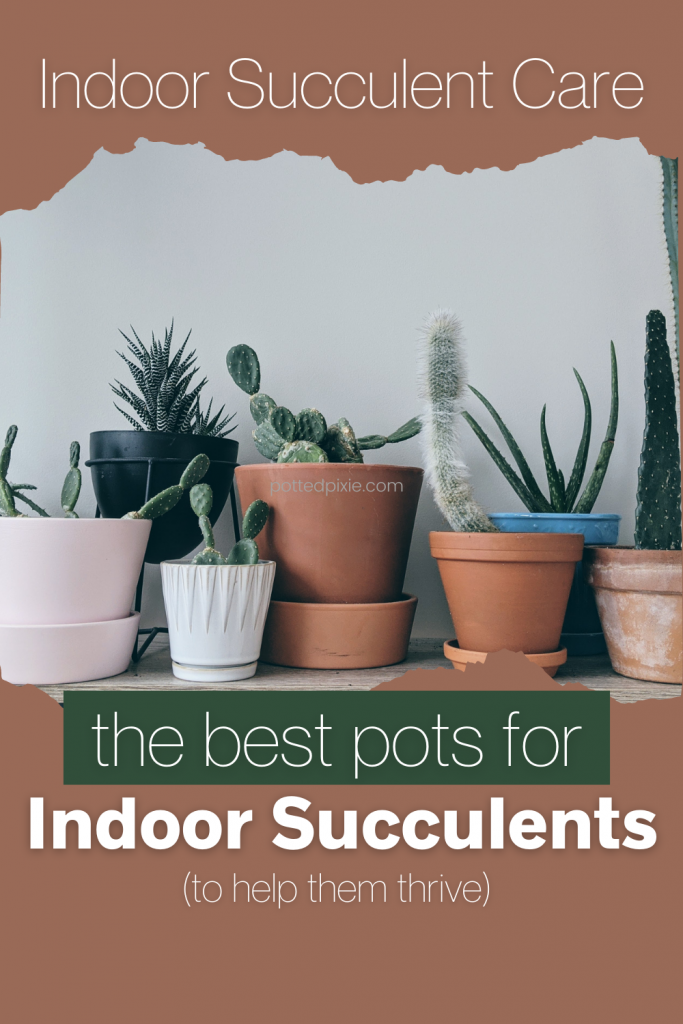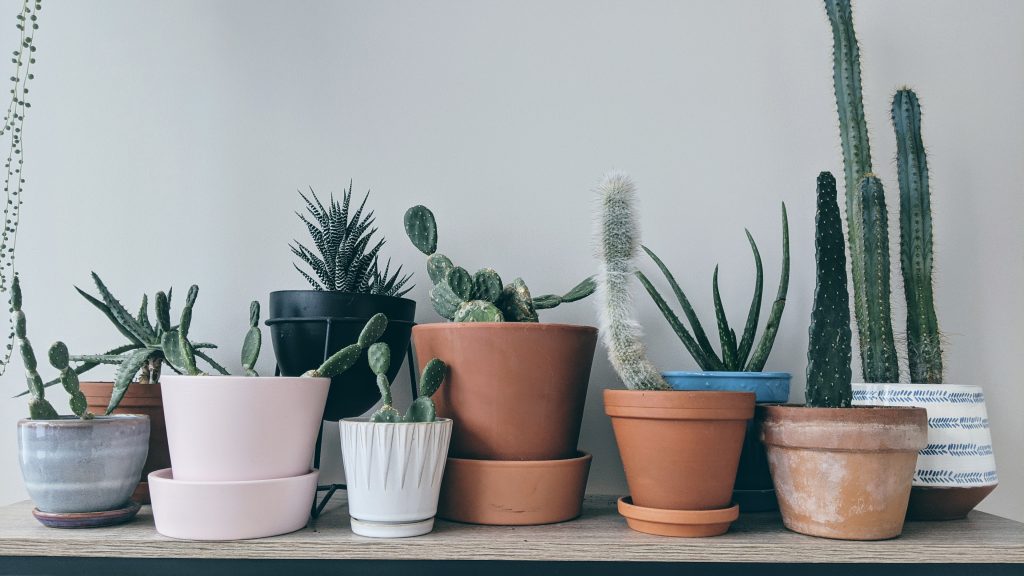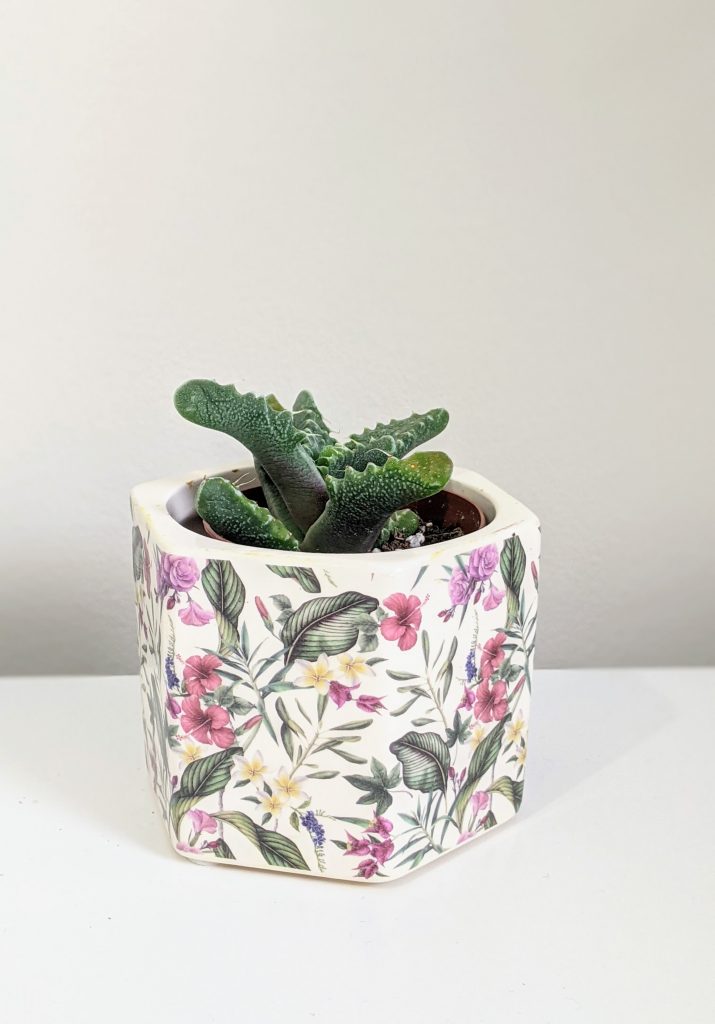Caring for indoor potted succulents and cacti starts with choosing the perfect pot.
The right type of soil and proper amount of sunlight and water are the other foundations for healthy houseplants.
Terracotta, ceramic and clay are the best pots for your indoor succulents because they allow maximum aeration, breathability and assist with getting rid of excess water.
Besides choosing pots made out of this material, you also need to consider size, drainage and potential issues to watch out for.
Let’s dig into everything you need to know about choosing the right pot for your succulent or cactus.

This post contains affiliate links, which means I may make a small commission if you click through and make a purchase.
Best Pots for Indoor Succulents, Cacti and Other Indoor Plants
There aren’t many differences between terracotta, clay and ceramic pots, but it can be helpful to know what sets them apart.
When it comes to plant pots, clay and ceramic are essentially the same thing.
A pot labeled as ceramic is just clay that’s been baked and hardened.
Terracotta pots are just a different kind of hardened clay that contains more iron, which is what produces the earthy reddish color.

Terracotta Pots
Terracotta pots are the best types of planters to use for your succulents, cacti and any other houseplants that like to dry out in between waterings.
Terracotta is a porous material and is therefore very breathable and allows lots of air movement and the soil to breathe.
But more importantly, terracotta pots prevent root rot by whisking excess water and moisture away from the soil – this prevents your plant roots from staying wet and rotting away.
I love these pots I found on Amazon, because they’re a uniform, cylindrical shape and not too deep.

For something a little more decorative, these pots are cute and have little feet so they’re raised up a bit.

And this style of pot would work well with boho-chic or mid century modern decor.

The only bad thing about using terracotta pots is that they’re heavy and fragile. Use a little extra care when moving them around.
If left outside, they can wear down more quickly due to changing temperatures and extra moisture.
But if you’re using them inside, they will last a long time.
Above all else, planting cacti and succulents in terracotta pots provides that quintessentially aesthetic desert look.
While the best plants for terracotta pots are succulents and cacti, other plants will thrive in these pots too, such as pothos, sansevieria, peperomia, hoyas, and zz plants.
Other moisture-loving plants, like tropicals, can be potted in terracotta containers, but you will have to be a little more diligent in checking the plant’s water needs.
Clay or Ceramic Pots

Clay or ceramic pots will also work just fine for your succulents. You should avoid using glazed ceramic as this will make your pot unbreathable, trapping excess moisture.
I like this ceramic pot that comes in pink, blue, white and black.
Plastic, Metal and Glass
You can get by with plastic pots for your succulents as long as they have drainage holes and you use an excellent, well-draining soil.
It’s imperative that you use a special soil mixture designed specifically for succulents and cacti to prevent them from holding on to excess water and avoiding root rot.
Look for soil that has a mix of perlite.
I like this soil mixture and you can buy it easily from Amazon.
Mixing in a little pumice will add extra drainage to ensure over-watering does not occur.
Avoid glass bowls and terrariums for planting your succulents. Not only is glass not breathable, most bowls don’t have drainage and the added light that can come through is not necessary.
This will create a humid environment, which is the opposite of an arid climate that we want for our cacti.
Similarly, metal pots should also be avoided, as they can get too hot and scorch your succulents.
Look for Pots with Drainage

Now that you’ve decided to go with terracotta or clay, make sure the pot you choose has at least one drainage hole on the bottom.
And most terracotta pots come with a matching saucer for the bottom to catch excess water.
Use mesh screens to cover the drainage holes to allow the water pass through but not the dirt.
This is even more important if you’re not using a saucer.
Some people use coffee filters, but I find that they become soggy and break down over time.
For long term success, don’t plant succulents in pots without holes. These types of plants do not like to be sitting in stagnant water and will eventually rot away.
Some people place pebbles at the bottom of the pot so that water has somewhere to escape from the soil. Unfortunately, this just prolongs the inevitable root rot.
But, I know the dilemma. You found the cutest container for your succulent, but there’s no hole (ask me how I know)!
If you insist on planting a succulent or a cacti in a pot without drainage holes, there are a couple things you can do.

I’ve drilled holes in the bottom of sturdy plastic pots and so for this has worked out well (as demonstrated by my string of pearls in the plastic pot above).
But the easiest way to use a pot without a drainage hole is to keep your succulent in its nursery pot.
When it comes to watering, just take it out and water it over the sink or a saucer, and when the water has stopped coming out of the bottom, just place it back in your decorative pot.
It will be perfectly happy in its nursery container for some time, but eventually it will outgrow it.
The Correct Size of Your Pot is Important
A potted cactus can grow quite well indoors, provided it’s in the proper sized pot.
When choosing a pot for your succulents, find one that’s just barely bigger than the size of the root ball. No more than half an inch larger is ideal.
A larger pot with more soil will create an environment that allows more water to stick around – which should be avoided.
When it comes to planting succulents and cacti, always choose a more shallow pot over a tall one.
Too much room in the pot will encourage the roots to grow at a much faster rate than the plant itself.
A good rule of thumb is that your succulent (and cactus) will always prefer a smaller pot over one that’s too big.
This is good news if you want to plant a cactus in a cute little pot.
There are so many adorable mini pots for succulents and cacti that you can place all over your house without them taking up too much space.
Gimme all the succs!

That being said, your cactus won’t grow bigger by putting it in a larger pot.
You will know when it has outgrown its current pot when the roots have started to come out the drainage hole, or its produced so many pups that it’s starting to get crowded.
Repotting Your Succulent and Cactus
The good thing about the slower growth rate of cacti is that they won’t have to be repotted very often. However, when you notice the roots are starting to grow through the drainage holes, it’s time to repot.
The best time to repot your cactus or succulent is right before you intend to water it.
You want it to be dry when placing it in its new pot and soil to avoid any chance of too much moisture.
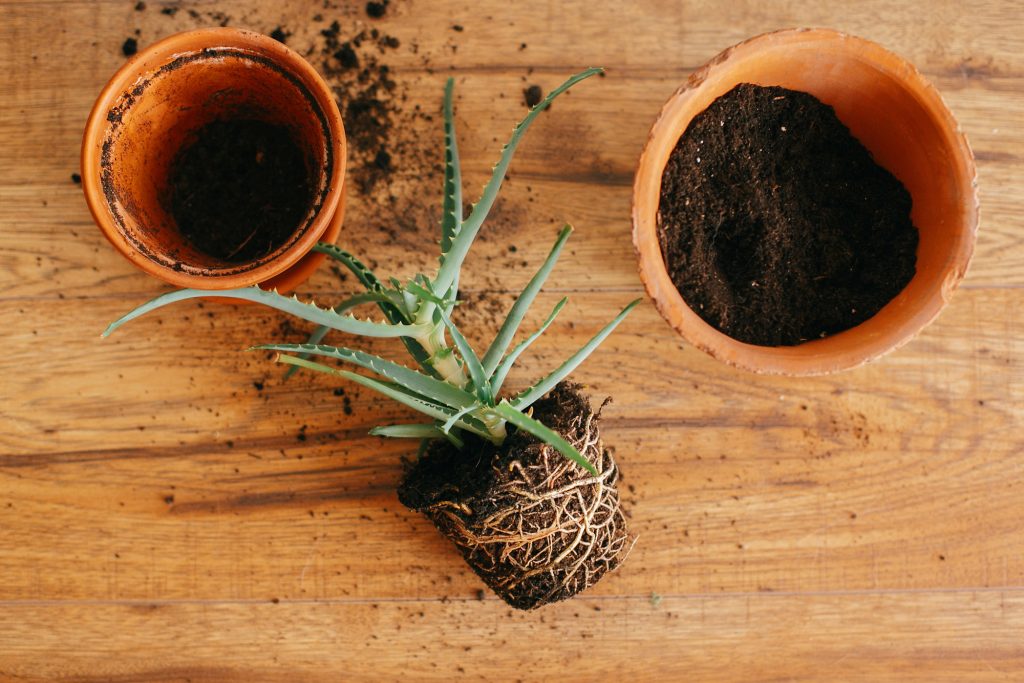
Lay out your succulent and measure how deep it is in comparison to your new pot. Fill the new pot with enough soil to bring your succulent about half inch below the top of the pot.
Slightly loosen up the root ball and then place in its new pot.
Use a spoon to fill the rest of the pot with soil until it’s lightly packed in. Wait a few days before watering so that the roots can find their new home before becoming too wet.
The best way to repot cactus without hurting yourself is to use a thick glove on one hand.
Then, use a folded pieces of newspaper (like you would to smack a fly) in the other hand to help you guide the cactus out of its pot.
If you’re dealing with a small cactus you could probably use kitchen tongs to lightly grab it.
Issues You May Run Into Using Terracotta or Clay Pots
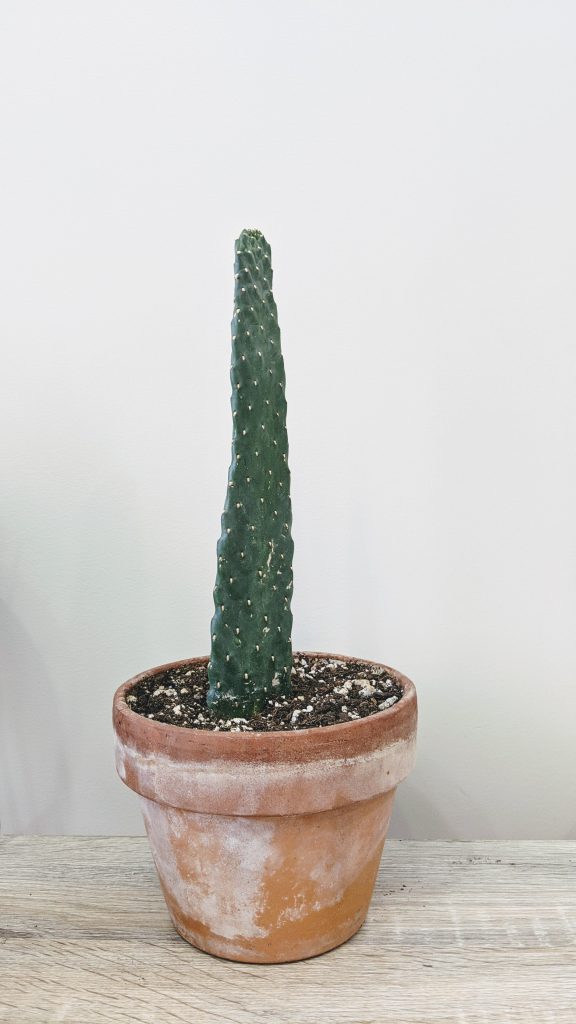
If you’re going to be reusing a terracotta pot, chances are there will be a crusty mineral build up on the inside.
You should always clean your pots before reusing them.
The best way I’ve found to do this is to use the vinegar mix with a handy flower pot bristle brush, which easily scrapes off all the crusty bits.

Stay Green!
>> Read Next: 13 Indoor Plant Tools to Boost Your Plant Parent Status to Expert!
